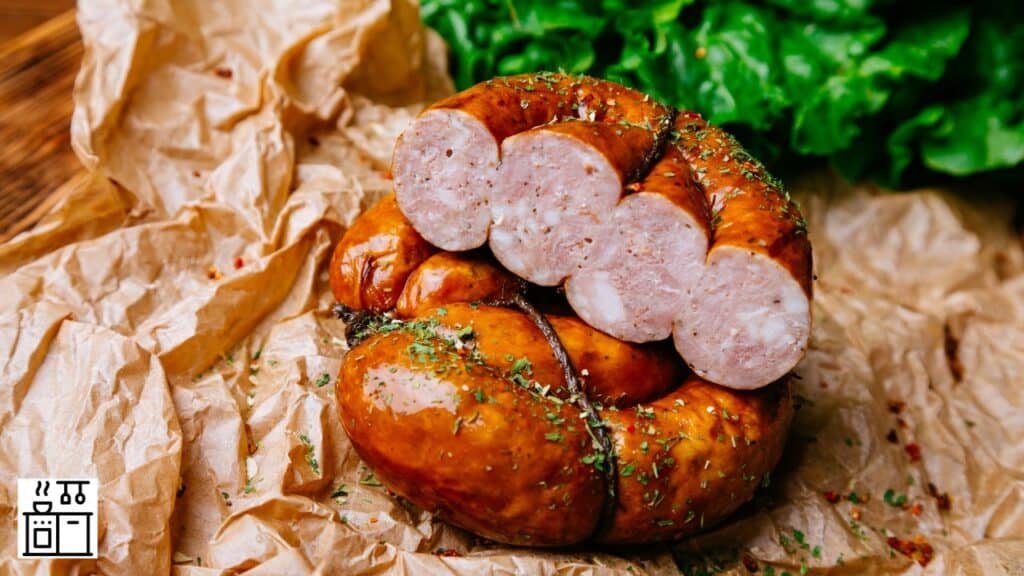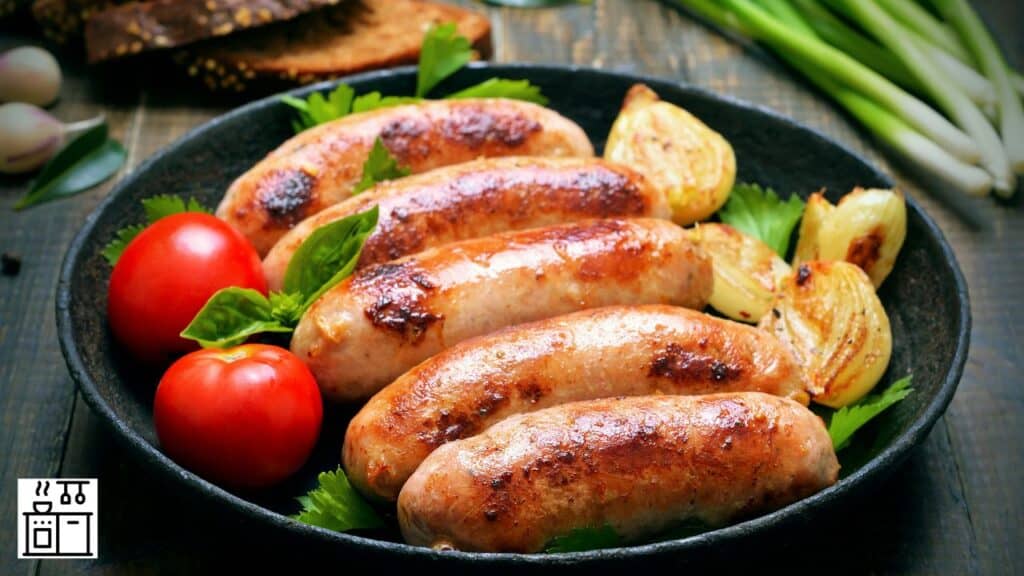Sausages are a staple food in many cultures across the world. They’re versatile ingredients that can be eaten on their own or added to various recipes. So, what is a sausage actually made of?
Traditional sausages are made from ground meat like pork, beef, or poultry. The meat is mixed with salt, seasoning, and fillers like breadcrumbs or grains. It’s then stuffed into tubular casings that are meat-based or made of synthetic materials. Vegan sausages have tofu, lentils, peas, or grains.
Let’s look at what sausages are in closer detail to understand them better.
Fun Facts About Sausages
As you would already know, meat is highly perishable. It spoils rapidly at room temperature.
Most meat products are unsuitable for consumption within hours of being cut.
Before refrigerators and cold-storage systems came into existence, it wasn’t easy to store meat.
Thus, sausages were invented as a technique to preserve meat. It began nearly two thousand years ago.
The term “sausage” is derived from the French word “saucisse,” which means seasoned with salt.
Technically, the term refers to minced or ground meat that is mixed and seasoned with salt and other spices.
However, it’s now used to refer to sausage meat that is encased in a cylindrical casing.
In the beginning, sausages were used as a means to preserve lesser-used meat parts, like the internal organs of slaughtered animals.
Less traditional and game meats were also preserved as sausages.
However, in the coming years, people started using all kinds of meat for sausages.
They were made from fine cuts or even leftover meat scraps.
Nevertheless, all types of sausages have:
- Ground meat,
- Filler, and
- Casing.
1. Ground Meat
Sausage is always made from ground or minced meat.
The meat can be from any animal, including pork, beef, poultry, venison, or game birds and animals.
Traditionally, sausages were made using off-cuts like liver, offal, and other butcher scraps.
The idea was to put every bit of the meat to good use and minimize wastage.
Specialty sausages also include blood sausages which are made by mixing the blood of the slaughtered animal with the meat.
The ground meat is mixed with salt and herbs for added flavor.
The seasonings are added before the meat is stuffed into the casing.
Modern sausages use preservatives to extend their shelf-life. These are mixed in with the meat.
2. Fillers
The meat is usually mixed with filler ingredients.
The purpose of using fillers is to give the sausage a proper structure.
During cooking, sausage meat contracts.
However, the moisture it releases gets absorbed by the filler material.
It expands and helps the sausage hold its shape.
Different types of fillers are used in sausages. Starchy fillers like breadcrumbs and grains are usually cheap.
Some manufacturers use plant-based ingredients like apple and leek. Synthetic fillers may also be used.
Recommended: Can You Refrigerate Cornbread? | Griddle Pan vs. Grill Pan vs. Frying Pan | 10 Ingredients Of Candy Corn | What Are Chicken Nuggets Made Of?
3. Casing
The casing holds the meat and gives it a specific shape. This makes it easier to handle.
There are two types of casings used for sausages:
- Natural, and
- Artificial.
Traditional sausage casings made from meat are called natural casings.
They’re usually made using the cleaned intestines or stomachs of the animal.
They’re edible and permeable to air.
Artificial sausage casings use collagen, cellulose, or other synthetic ingredients. They’re generally not edible.
Some manufacturers even use plastic casings for sausages.
These casings are used to hold the meat in place until they’re cooked or cured.
They are removed before consuming the sausage.
The casing is usually transparent and has a cylindrical structure.
It expands to hold the minced meat.
5 Different Types of Sausages
“Sausage” is a very broad term used to describe a variety of foods made by stuffing minced or ground meat into cylindrical casings.
We can differentiate them in different ways. Let’s look at the various types.
1. Fresh Sausages
Fresh sausages are uncooked sausages made with raw meat. You shouldn’t eat them raw.
These sausages require refrigeration, as the meat is uncooked.
You should also thoroughly cook them before consumption.
It’s very important to follow essential food safety measures when handling fresh sausages.
You should clean all surfaces that they touch because they’re made using raw meat.
You should also wash your hands thoroughly after handling them.
2. Smoked Sausages

Smoked sausages are partially-cooked.
They’re placed in a smokehouse or smoker and exposed to smoke from a wood stove.
The smoke serves two purposes—cook the meat partially or entirely and flavor the sausage.
Partially-cooked smoked sausages need further cooking.
Fully-smoked sausages can be consumed directly.
Neither requires refrigeration because the meat undergoes processing and doesn’t spoil rapidly.
Smoked sausages usually develop a unique smoky flavor from the smoke they’re exposed to.
Some examples are chorizo and kielbasa.
These are treated as gourmet food and are a specialty item in delis and smoke-houses.
3. Dried Sausages
Dry sausages are fully cured and dried.
They undergo a fermentation process, due to which they develop a hard texture.
The curing process also makes the flavors more concentrated.
The curing process for dry sausages involves encasing the seasoned meat in salt.
It’s then air-dried for several weeks.
This draws out the moisture and essentially cooks the sausages.
The resulting product is completely-processed and dry.
Hence, it will not spoil and holds up at room temperature for a long time.
You need not refrigerate or cook it before consumption. Salami is a type of dry sausage.
4. Cooked Sausages
Cooked sausages are made with fresh meat and are fully cooked. These sausages may also be smoked after cooking.
Cooked and uncooked smoked sausages need refrigeration if you don’t consume them immediately.
Hot dogs, Braunschweiger, and Mortadella are examples of cooked sausages.
5. Vegetarian Sausages
Traditional sausages always use meat as the filling.
However, vegetarian and vegan versions are also available now.
These sausages use various plant-based ingredients like soya, tofu, pulses, nuts, grains, and vegetables.
They also have filler ingredients that help them hold their original shape during cooking.
You can cook these sausages or add them to any recipe, just as meat sausages.
Some of these sausages closely replicate the taste of meat-based sausages.
However, the nutritional content depends on their ingredients.
Most vegetarian sausages require refrigeration and don’t hold up at room temperature.
How Do Sausages Taste?
Different cultures across the world have their versions of sausages.
They use different types of meats, herbs, and flavoring agents to create unique sausage recipes.
So the taste and texture will differ across variants.
The taste of any sausage will depend on the type of meat, processing technique, cooking method, and flavoring agents used.
Fresh sausage generally has a soft and moist texture because it contains uncooked fat and filler ingredients.
Dried and smoked sausages are usually more flavorful because the flavors infuse strongly during the processing stage.
They’re also denser and chewier than fresh sausages.
Related: How To Choose Oils For Deep Fryers? | Can Rice Cooker Be Left On Overnight?
How To Store Sausages?
The best storage method for sausages will depend on the type of sausage.
Fresh sausages spoil rapidly because they’re made with raw, uncooked meat.
You must refrigerate them to prevent spoiling.
When stored in the original packaging, fresh sausages keep for two to three days.
It’s best to check the package instructions and use them before the best-by date.
These sausages will hold up for longer in the freezer.
They last for a few months when stored in an airtight, freezer-safe bag.
Smoked and dried sausages can be stored at room temperature.
However, it’s important to place them in a dry space, away from moisture and sunlight.
These sausages will usually keep in the pantry for up to two months.

